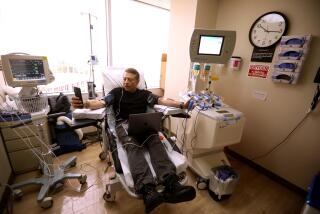Rays of hope for macular degeneration
- Share via
Suddenly, a perfectly straight telephone pole appears crooked. The yellow line down the middle of the road turns wavy. A soft, blurry spot appears in the middle of a friend’s face.
This is how age-related macular degeneration, the leading cause of blindness in America, often manifests itself before widening its swath through a person’s vision. For its victims, life is never the same.
“I did all my own work around the house, carpentry, plumbing, electrical -- I miss that,” said Arnold Rasnake, 82, a retired welder from Rosedale, Md., who noticed his first symptoms in April.
“I can see well enough to do my housework,” said his wife, Barbara, 81, who became legally blind five years ago. “But I used to sew, and I did a lot of altering for people. That’s all over.”
With the number of victims expected to nearly double in the next 20 years as the baby boom population ages, doctors and patients are understandably excited about any treatment that offers hope, however modest.
So when researchers reported some success recently with a drug that fights the root cause of the disease -- the uncontrolled spread of blood vessels behind the retina -- some doctors were unabashedly talking about a “new era.”
To put that assessment into perspective, no one’s macular degeneration is being cured with pegaptanib, the awkwardly named drug reviewed in the Dec. 30 issue of the New England Journal of Medicine. But the drug does appear to slow the disease’s progression, which is no small advantage to people at risk of going blind.
In two clinical trials at 117 sites in the United States, Canada, Europe, Australia and South America, doctors found that people treated with the drug early in their illness lost less vision over a one-year period than those who went untreated.
For some, it meant a reduced risk of losing the ability to see six lines on an eye chart, which is considered severe vision loss. For others, it prevented moderate vision loss.
Only 10% of people receiving treatment could be expected to see any improvement in their vision, according to the study.
What interests doctors, perhaps more than the results of the trials, is the fact that the medication is the first based on a new mechanism of action that has shown significant benefit.
“It makes it less likely that the blood vessels will continue to grow and less likely that those blood vessels will continue to leak,” said Dr. Neil Bressler, a retina specialist at the Wilmer Eye Institute at Johns Hopkins Hospital who treated and evaluated patients in the study.
The trials amounted to a “proof of principle,” the first evidence that attacking a disease with a particular treatment can work. And with similar drugs being tested in clinical trials, physicians hope that some might work even better.
“This drug is good but it may be a bellwether of a lot of things to come,” said Dr. Frederick L. Ferris III, clinical director of the National Eye Institute.
It’s also possible that pegaptanib combined with older therapies might improve patients’ eyesight more than one treatment alone. That strategy, known as combination therapy, has transformed the treatment of cancer and AIDS.
Scientists fighting macular degeneration face a formidable foe.
The eye has two circulation systems that run on parallel planes -- one on the retina itself, the other on a membrane just behind the retina. They are among the fastest and most densely packed networks of blood vessels in the human body, surpassed only by the liver’s circulation.
One of the vessels’ functions may be to cool the retina, protecting it from the potentially damaging rays of light that the lens focuses onto fragile tissue.
As people age, tissue in this region may at some point cry out for more circulation. The result is often an overproduction of capillaries in the center of the retina, a spot called the macula that provides the sharpest images.
These vessels take up space required for vision, but they do their worst damage by bleeding into surrounding tissue. What’s left is fibrous scar tissue that creates a hole in a victim’s central-field vision. Eventually, that hole may grow outward and erase the entire field of vision.
Today, an estimated 1.75 million people in the United States are in the advanced stages of macular degeneration, which normally attacks people 55 and older. But with people living longer and baby boomers entering their period of greatest risk, the number is expected to grow to almost 3 million people in less than two decades.
For the Rasnakes, living with macular degeneration has required one adjustment after another
Barbara, for instance, can read only with the aid of a magnification device that displays the printed word on a screen.
“I read my Bible a couple or three times a week, and I’ve been using it to read all of my Christmas cards,” she said, showing a visitor how a friend’s handwriting appears several inches tall on the screen. Sometimes she wears strap-on binoculars to watch TV, but she says the device is less than ideal because it displays only part of the action.
Arnold says he drives only in daylight and avoids rush hour. He has stopped trying to repair things around the house after finding that he could no longer see well enough to insert a screwdriver into a slot.
Twenty years ago, eye specialists hoped that they could make serious inroads by subjecting the errant blood vessels to lasers. This indeed closed the vessels, but it also destroyed nearby retinal tissue that people can least afford to lose.
In the last decade, a new treatment called photodynamic therapy has proved more useful. First, patients receive an infusion of a medication that travels to the affected area. Minutes later, an infrared laser focused onto the retina activates the drug, which in turn closes the abnormal vessels.
The advantage, said Ferris, is that the treatment does not destroy retinal tissue. But its effects are limited. Clinical trials have shown that it can lower the risk of severe vision loss by 30% to 50%. Unfortunately, he noted, most patients don’t begin treatment until they have already lost substantial vision. And many continue to lose sight after repeated treatments.
Was photodynamic therapy a disappointment?
“It depends on someone’s expectations,” said Bressler. Just one in 20 people who couldn’t read before treatment could read afterward, so anyone expecting big improvements would surely have been let down, he said.
“But if the expectation was that ‘I’m going to take the 70% of people that go on to lose a moderate amount of vision and I’m going to make that 45%’ -- then that’s a step in the right direction. Or, if it’s that ‘I’m going to take the one out of three people who lose lots of vision and make that one out of six,’ that’s good.”
The new drug works by combating angiogenesis, the growth of new blood vessels. It does this by turning off receptors on the surface of vessels that would otherwise be stimulated by growth factors.
To inject the drug, doctors numb the eye with a topical anesthetic and then press a half-inch-long needle through the white of the eye into the middle cavity. “It feels like pressing on the eye with a Q-tip,” said Bressler.
For the trial, patients had the drug injected into one eye every six weeks for a year.
For patients receiving “sham” injections for the sake of comparison, doctors pressed an identical syringe with no needle against the eye.
Bressler and Ferris said the drug was actually no better than photodynamic therapy, and pointed to the “proof of principle” as the real news.
But Dr. Evangelos S. Gragoudas, the principal investigator and director of retina services at the Massachusetts Eye and Ear Infirmary, said such assessments might understate the drug’s benefits. It is difficult to compare the two because they were not tested in a head-to-head trial, he said.
Gragoudas said the drug was suitable for a wider range of patients -- it didn’t matter how much retinal damage a patient had already sustained -- and was the first treatment that attacked the source of the disease rather than its consequences.
“Myself, I would use the drug first because certainly the results are equal or better,” said Gragoudas, adding that he expected physicians to begin small trials of combination treatments soon.
Bressler said many doctors might use the drug as a second resort, for patients who didn’t benefit much from photodynamic therapy or weren’t candidates for it in the first place.
“Thirty years ago, we treated none of this,” he said. “For degenerative conditions that involve the retina or the brain, every little step may not be so significant in itself, but they add up. Maybe this is another step.”






